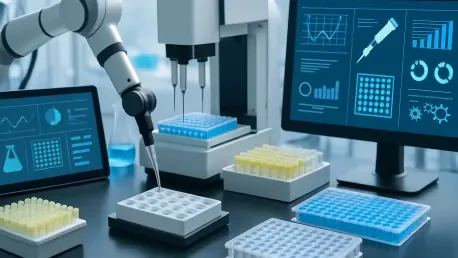In the rapidly advancing realm of analytical laboratories, the drive toward digital transformation is fundamentally altering the landscape of scientific research and experimentation, as labs across the globe wrestle with persistent challenges. These challenges include fragmented systems, disjointed workflows, and entrenched data silos that stifle progress and efficiency. Amid this complex backdrop, a transformative concept emerges as a potential game-changer: the Digital Lab OS. This innovative framework is envisioned as a unifying force, integrating disparate software, hardware, and informatics systems into a seamless, automated ecosystem. Drawing an analogy to a computer operating system that simplifies hardware complexities for users, Digital Lab OS promises to abstract technical intricacies, allowing scientists to focus on discovery rather than logistics. This approach could redefine laboratory automation, breaking down barriers and paving the way for accelerated scientific breakthroughs in an era hungry for innovation.
Tackling the Persistent Issue of Fragmentation
The road to a fully digital laboratory is fraught with obstacles, chief among them being the pervasive issue of fragmentation that hampers operational harmony. Many labs struggle with inconsistent data formats, a problem that persists even among instruments produced by the same manufacturer. Legacy systems, often built on outdated technology, further exacerbate the situation by lacking the interoperability required to meet modern demands. These disconnected setups create isolated data pools, making it nearly impossible to establish streamlined workflows. Digital Lab OS steps in as a potential solution, aiming to standardize interactions across diverse platforms and enable data to flow effortlessly. By reducing the need for manual intervention, this framework seeks to dismantle the silos that currently fragment laboratory environments, offering a path toward cohesive and efficient operations that can support the complex needs of scientific research.
Beyond the technical challenges, cultural resistance adds a significant layer of difficulty to achieving digital integration in labs. Many scientists and senior leaders exhibit reluctance to adopt new processes, often due to a deep-seated fear of change or a protective stance over data perceived as proprietary. This hesitancy can stall even the most promising technological advancements, as familiar manual methods are favored over unfamiliar automated systems. Digital Lab OS addresses not only the mechanical aspects of integration but also underscores the need for a cultural shift within the scientific community. Encouraging collaboration and fostering trust in shared, automated platforms are essential components of this framework’s vision. By promoting a mindset that values openness and adaptability, it aims to align human and technological progress, ensuring that labs can fully embrace the benefits of digital transformation without being hindered by outdated attitudes or practices.
Envisioning a Future of Seamless Integration
At the heart of Digital Lab OS lies the ambitious goal of orchestration, which seeks to unify software, hardware, and automation into fluid, integrated workflows that enhance laboratory functionality. Much like a computer operating system abstracts the intricacies of hardware to provide a user-friendly experience, this framework allows scientists to concentrate on critical research questions—such as evaluating compound purity or identifying impurities—without being bogged down by incompatible data formats or instrument-specific challenges. The vision is one of a laboratory where technology operates unobtrusively in the background, eliminating logistical distractions and freeing up intellectual capacity for innovation. This approach could transform the daily experience of lab work, shifting the focus from managing technical hurdles to driving scientific inquiry forward with unprecedented clarity and purpose.
Practical examples of this vision are already emerging through advanced platforms that embody the principles of Digital Lab OS. Such systems act as a “data fabric,” weaving together diverse elements like electronic lab notebooks, laboratory information management systems, robotics, and automated work cells into a coherent network. By ensuring that the right information reaches the appropriate personnel at the precise moment it’s needed, these platforms illustrate the transformative potential of seamless integration. They harmonize complex workflows, breaking down barriers between disparate systems and creating an environment where data accessibility is no longer a bottleneck. This glimpse into the future of lab automation highlights how Digital Lab OS can convert fragmented, inefficient setups into dynamic, efficient hubs of discovery, setting a new standard for how laboratories operate and collaborate on a global scale.
Enhancing Speed and Consistency Through Automation
One of the most compelling promises of Digital Lab OS is its capacity to significantly boost efficiency by addressing the labor-intensive manual processes that dominate many laboratory settings. Routine tasks, such as storing High-Performance Liquid Chromatography (HPLC) data in shared folders for later retrieval, are not only time-consuming but also susceptible to human error, leading to delays and inaccuracies. Digital Lab OS introduces automation to these back-end operations, delivering faster access to critical insights and ensuring consistency across experiments. This level of repeatability is vital for maintaining scientific integrity, as it minimizes variations that can skew results. By standardizing and automating workflows, the framework prevents the perpetuation of outdated, customized data practices that often burden individual scientists, thus paving the way for a more reliable and swift research process.
The benefits of this automation extend across the diverse roles within a laboratory, catering to the unique needs of scientists conducting experiments, execution teams managing robotics, and auditors ensuring compliance with regulatory standards. Digital Lab OS creates a unified system that supports operational speed while maintaining traceability for compliance purposes, ensuring that every stakeholder can perform their duties without unnecessary friction. This holistic approach transforms the lab into an environment where technology serves as an enabler rather than a hindrance, allowing for rapid progress in scientific endeavors. By aligning automation with the varied demands of lab operations, the framework not only enhances efficiency but also fosters an atmosphere of trust in digital tools, encouraging broader adoption and ultimately contributing to the acceleration of groundbreaking discoveries.
Paving the Way for Scientific Advancement
Reflecting on the journey of laboratory automation, it’s evident that the strides taken with concepts like Digital Lab OS mark a turning point in overcoming entrenched challenges. The persistent issues of fragmentation and cultural resistance have been met with innovative solutions that prioritize integration and collaboration. Platforms embodying this framework have demonstrated their worth by weaving together complex systems into streamlined workflows, ensuring data is no longer a barrier but a bridge to discovery. These early steps showcase a tangible shift, as labs begin to shed inefficiencies in favor of automated precision.
Looking ahead, the focus must shift to actionable strategies that build on these foundations. Encouraging widespread adoption of unifying frameworks requires not just technological investment but also targeted efforts to shift mindsets within the scientific community. Initiatives to educate and demonstrate the tangible benefits of automation can help dismantle resistance. Furthermore, fostering partnerships across vendors and labs to standardize data formats will be crucial in sustaining momentum. By prioritizing these steps, the legacy of Digital Lab OS can evolve into a catalyst for a future where science moves faster, unencumbered by logistical constraints.









